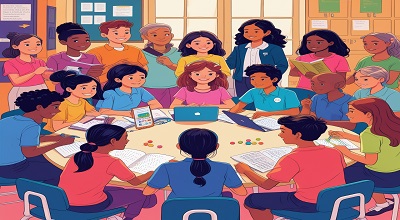Universal Design in Education
Universal Design in Education (UDE) is an inclusive approach aimed at creating learning environments that accommodate all students, regardless of their abilities, disabilities, or learning styles. Rooted in the broader concept of Universal Design (UD), which originated in architecture, UDE ensures that educational materials, teaching methods, and assessments are accessible to everyone.
The Universal Design for Learning (UDL) framework, developed by CAST (Center for Applied Special Technology), provides a structured way to implement these principles. UDL emphasizes flexibility, inclusivity, and equity in education, ensuring that no student is left behind.
Why is Universal Design Important in Education?
- Promotes inclusive education
- Reduces barriers for students with disabilities
- Enhances learning for all students, including English Language Learners (ELLs) and gifted students
- Encourages engagement, representation, and expression
Principles of Universal Design for Learning (UDL)
UDL is built on three core principles, each focusing on different aspects of learning:
1. Multiple Means of Engagement (The “Why” of Learning)
- Motivate students by offering choices in assignments.
- Use gamification, interactive lessons, and real-world applications.
- Example: Allowing students to choose between writing an essay or creating a video presentation.
2. Multiple Means of Representation (The “What” of Learning)
- Present information in various formats (text, audio, video, infographics).
- Use closed captions, transcripts, and alternative text for accessibility.
- Example: Providing a podcast alongside a textbook chapter for auditory learners.
3. Multiple Means of Action & Expression (The “How” of Learning)
- Allow students to demonstrate knowledge in different ways (writing, speaking, drawing).
- Use assistive technologies like speech-to-text software.
- Example: Letting students take a verbal exam instead of a written one.
Benefits of Universal Design in Education
Implementing UDL in classrooms offers numerous advantages:
1: For Students:
- Personalized learning experiences
- Increased engagement and motivation
- Better academic performance
2: For Teachers:
- Reduces the need for individual accommodations
- Encourages creative teaching strategies
- Improves classroom management
3: For Institutions:
- Compliance with accessibility laws (e.g., ADA, IDEA)
- Higher student retention rates
- Positive reputation for inclusivity
Examples of Universal Design in the Classroom
Here are practical examples of UDL implementation:
1. Flexible Seating Arrangements
- Allows students to choose where they learn best (standing desks, bean bags, quiet corners).
2. Digital Textbooks with Audio Support
- Helps visually impaired students and auditory learners.
3. Interactive Whiteboards with Touchscreen Features
- Engages kinesthetic learners.
4. Varied Assessment Methods
- Options like oral presentations, projects, or digital portfolios instead of only written tests.
5. Use of Assistive Technologies
- Screen readers, speech-to-text tools, and braille displays for students with disabilities.
More Read: 6G Network Vulnerabilities
Technology and UDL
Modern technology plays a crucial role in UDL implementation:
Key Tools for UDL:
- Google Read & Write (Text-to-speech tool)
- Khan Academy (Personalized learning paths)
- Nearpod (Interactive lessons)
- Bookshare (Accessible eBooks for dyslexic students)
Challenges and Solutions in Implementing UDL
Common Challenges:
- Lack of teacher training
- Resistance to change
- Budget constraints for assistive tech
Solutions:
- Professional development workshops
- Grants and funding for inclusive tech
- Peer collaboration among educators
Future Trends in Universal Design for Learning
- AI-powered personalized learning
- Virtual Reality (VR) for immersive education
- Increased policy support for UDL globally
Conclusion
Universal Design in Education ensures equal learning opportunities for all students. By adopting UDL principles, educators can create flexible, engaging, and accessible classrooms. The future of education lies in inclusivity, and UDL is the key to achieving it.
Free Download: Rejekibet APK
